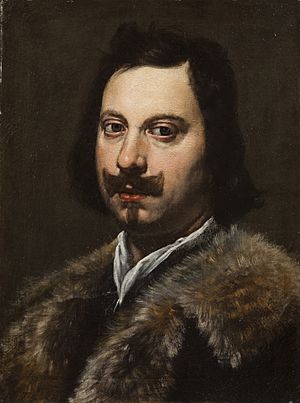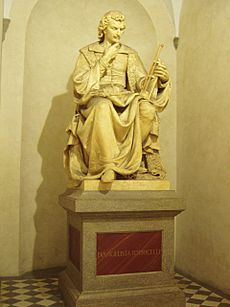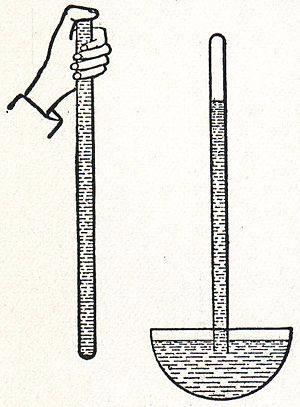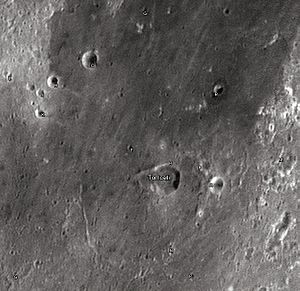Evangelista Torricelli facts for kids
Quick facts for kids
Evangelista Torricelli
|
|
|---|---|

Evangelista Torricelli by Lorenzo Lippi (c. 1647)
|
|
| Born | 15 October 1608 |
| Died | 25 October 1647 (aged 39) |
| Nationality | Italian |
| Alma mater | Sapienza University of Rome |
| Known for | Barometer Torricelli's experiment Torricelli's equation Torricelli's law Torricelli point Torricelli's trumpet Torricellian vacuum |
| Scientific career | |
| Fields | Physics Mathematics |
| Institutions | University of Pisa |
| Academic advisors | Benedetto Castelli |
| Notable students | Vincenzo Viviani |
| Influences | Galileo Galilei |
| Influenced | Robert Boyle Blaise Pascal |
Evangelista Torricelli (born October 15, 1608 – died October 25, 1647) was a smart Italian scientist. He was a physicist and mathematician. Torricelli was also a student of the famous scientist Galileo. He is most famous for inventing the barometer. This tool measures air pressure. He also made important discoveries in optics (how light works) and mathematics. The unit of pressure called the Torr is named after him.
Contents
Biography
Early Life and Education
Evangelista Torricelli was born in Rome on October 15, 1608. He was the first child of Gaspare Torricelli and Caterina Angetti. His family came from Faenza, which was part of the Papal States at that time. His father worked with textiles, and the family was quite poor.
Because his parents saw how talented he was, they sent him to be educated in Faenza. His uncle, Giacomo, a Camaldolese monk, took care of him. Giacomo made sure Evangelista got a good basic education. In 1624, Torricelli went to a Jesuit College. There, he studied mathematics and philosophy until 1626.
After his father died, his uncle sent Torricelli to Rome. He studied science under Benedetto Castelli, a Benedictine monk. Castelli was a professor of mathematics at the Collegio della Sapienza, which is now the Sapienza University of Rome. Castelli was also a student of Galileo Galilei. Torricelli worked as Castelli's secretary from 1626 to 1632. This allowed him to learn a lot and be part of experiments.
In Rome, Torricelli also became friends with the mathematician Bonaventura Cavalieri. He also befriended two other students of Castelli: Raffaello Magiotti and Antonio Nardi. Galileo affectionately called Torricelli, Magiotti, and Nardi his "triumvirate" (a group of three important people) in Rome.
Career and Discoveries
In 1632, after Galileo published his book Dialogue Concerning the Two Chief World Systems, Torricelli wrote to Galileo. He told Galileo how much he enjoyed the book. Torricelli also mentioned that he believed in Copernicus's idea that the Earth goes around the Sun. This was a brave statement because the Church had condemned Galileo for this belief.
Not much is known about Torricelli's life between 1632 and 1641. In 1641, Castelli sent Torricelli's paper on how projectiles move to Galileo. Galileo was under house arrest at his villa in Arcetri. Galileo invited Torricelli to visit, but Torricelli only went three months before Galileo died. This was after Torricelli's mother passed away.
After Galileo died on January 8, 1642, the Grand Duke Ferdinando II de' Medici asked Torricelli to take Galileo's place. He became the grand-ducal mathematician and a professor of mathematics at the University of Pisa. In this new role, Torricelli solved many big math problems of his time. For example, he found the area and center of gravity of a cycloid (a special curve).
He wrote a book called Opera Geometrica in 1644, where he shared his findings. This book made him very respected in geometry. Torricelli was also interested in Optics. He found a way to make tiny lenses from glass that could be easily melted. He used this to design and build telescopes and simple microscopes. Some large lenses with his name are still kept in Florence.
Death
Torricelli died in Florence on October 25, 1647, just 10 days after his 39th birthday. He likely died from typhoid fever. He was buried at the Basilica of San Lorenzo. He left all his belongings to his adopted son, Alessandro. Even after his death, people admired his genius. An old book from 1715 about his lectures had an anagram that said, "Here blossoms another Galileo."
Honours
Many things have been named in honor of Evangelista Torricelli:
- In Faenza, a statue of Torricelli was built in 1868.
- The asteroid 7437 Torricelli and a crater on the Moon are named after him.
- The Torricelli Mountains in New Guinea carry his name.
- In 1830, a plant genus called Torricellia was named after him.
Torricelli's Work in Physics
Torricelli was inspired by Galileo's book Two New Sciences (1638). He developed many ideas about how things move. He wrote a paper called De motu (On Motion), which was published in his Opera geometrica in 1644.
Suction Pumps and the Barometer
Torricelli's work led to new ideas about air pressure. It also led to the invention of the mercury barometer. A barometer is a tool that measures the pressure of the air around us.
The idea for the barometer came from a problem: suction pumps could only lift water up to about 10 meters (34 feet). Galileo, Torricelli's teacher, thought this happened because of a "force of vacuum." But this didn't explain why water stopped rising at 10 meters.
After Galileo died, Torricelli suggested a different idea. He said that we live in a "sea of air" that pushes down on everything. This air pressure is like the pressure of water on objects underwater. He thought that at sea level, the air's weight is about the same as the weight of a 10-meter column of water.
When a suction pump creates a vacuum, the air no longer pushes on the water inside the tube. But it still pushes on the water outside. This causes the water to rise until its weight balances the air's weight. Torricelli predicted that if mercury, which is 13 times heavier than water, was used, it would only rise to 1/13 the height of water (about 76 centimeters).
In 1643, Torricelli did an experiment. He filled a meter-long glass tube, sealed at one end, with mercury. He then put the open end into a basin of mercury. When he lifted the sealed end, the mercury level in the tube fell. It stopped at about 76 centimeters (30 inches) above the mercury in the basin. This created an empty space above the mercury in the tube, which is now called a Torricellian vacuum. This was the first time a permanent vacuum was created.
Later, Blaise Pascal used Torricelli's idea to make another prediction. He said that the mercury column in a barometer should drop at higher elevations. Pascal proved this by showing the mercury dropped slightly on a tall bell tower. It dropped even more on a 1460-meter mountain.
Today, we know that the height of the mercury column changes with atmospheric pressure. This is very important for weather forecasting. The change in height at different elevations is also used in altimeters. Altimeters measure altitude and are used in hiking, climbing, and aviation. Torricelli's work laid the groundwork for our understanding of air pressure. The unit of pressure called the torr is named after him.
Torricelli's Law
Torricelli also discovered a law about how fast a fluid flows out of a hole. He found that water leaks out of a small hole at the bottom of a container at a speed related to the square root of the water's depth. This means that the deeper the water, the faster it flows out. This law was later shown to be a special case of Bernoulli's principle.
Torricelli's Principle
The idea of the center of gravity was discovered by Archimedes. Torricelli built on this. He discovered an important new principle: if several objects are connected so that their center of gravity cannot move up or down, then those objects are in balance. This is a version of the principle of virtual work. Christian Huygens later used this principle to study how pendulums move.
The Study of Projectiles
Torricelli also studied how objects, like cannonballs, travel through the air. One of his most important achievements was developing the idea of an envelope. He showed that if projectiles are launched at the same speed in all directions, they create parabolas. These parabolas all touch a common paraboloid, which he called the parabola di sicurezza (parabola of safety).
Torricelli's Work in Mathematics
Torricelli is also famous for the Torricelli's trumpet, also known as Gabriel's Horn. This is a shape that has an infinite surface area but a finite volume. This seemed like an "incredible" puzzle to many people at the time, including Torricelli himself. It led to a big debate about the nature of infinity. Some believe it helped lead to the idea of a "completed infinity."
Torricelli was also a pioneer in the study of infinite series. In his 1644 work De dimensione parabolae, he showed how certain series of numbers can add up to a specific value. He also helped develop the method of indivisibles from Cavalieri. Many mathematicians in the 1600s learned about this method from Torricelli because his writings were easier to understand than Cavalieri's.
Italian Submarines
Several Italian Navy submarines have been named after Evangelista Torricelli:
- A Micca class submarine, built in 1918.
- An Archimede class submarine (1934), later transferred to Spain.
- A Benedetto Brin class submarine (1937), which sank in 1940.
- Evangelista Torricelli, a former US submarine, transferred to Italy in 1960.
Selected Works
Torricelli's original writings are kept in Florence, Italy. Some of his published works include:
- Trattato del moto (before 1641)
- Opera geometrica (1644)
- (in fr) Traicté du mouvement des eaux. Castres: Bernard Barcouda. 1664. https://gutenberg.beic.it/webclient/DeliveryManager?pid=4614132.
- Lezioni accademiche (Florence, 1715)
- Esperienza dell'argento vivo (Berlin, 1897)
Images for kids
-
1959 Evangelista Torricelli commemorative stamp of the U.S.S.R.
See also
 In Spanish: Evangelista Torricelli para niños
In Spanish: Evangelista Torricelli para niños
- Geometric median
- Logarithmic spiral
- Torricellian chamber
- Vena contracta
- Gasparo Berti
- Stefano degli Angeli








